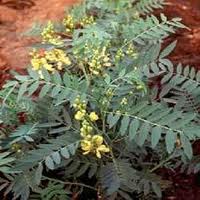

Senna Cultivation

Senna is a small perennial shrub of less than a meter in height ascending branches. The leaves are compound pinnate, petiolate about 10 cm long and bear 5-8 pairs of leaflets each on a small stalk.
The plant is found growing in a wild state in certain coastal parts of Gujarat in the Bhuj region of India and in some places of Rajasthan. Senna is grown in deserted big area of land. Farmers are very poor so they are not using any fertilizers and pesticides. So it is said to be that the north India is pesticide free. Farmers are in millions so can't be controlled.
LAND PREPARATION:
Sandy and sandy loam soils are suitable for the cultivation of this crop. Before monsoon farmers plough their lands to remove the weeds etc, and keep their field ready for sowing. Planking and removal of weeds and residues of the crop are essential for better germination and proper growth of the crop. The land is ploughed deep and the soil is exposed to sun for 110-115 days to dryout roots of perennial weeds followed by two cross ploughing harrowing and leveling.
NURSERY RAISING AND PLANTING:
The crop is raised by seeds. The seeds have hard and tough seed coat. Soaking seeds for 10-12 hours before sowing. About 6-8 kg of seeds are required to cover a hectare of land.
Under north Indian conditions like Rajasthan & Gujarat where the rainy season is short, it is reported to be the ideal time (June-July) to spread the seeds in their land and again they plough the field to cover the seeds and to ensure uniform sowing as the plants put on luxuriant growth and give the maximum growth. Heavy rains and cloudy weather during growth are harmful to the crop. An average rainfall of 25-40 cm. distributed from June to October is sufficient to produce good crop.
After sowing there is some rain which motivate initial stage of growing. When the plant grows ½" height the entire land looks beautiful green color. Then the farmers start removing weeds for healthy growing of the crop.
WEEDING:
Normally, weeding is not required in the fields of Gujarat & Rajasthan where senna crop is grown. If required, hand weeding is done in some fields.
MANURES, FERTILISERS AND PESTICIDES:
The medicinal plants have to be grown without chemical fertilizers and use of pesticides. Organic manures like, Farm Yard Manure (FYM), Vermi-compost, Green manure, etc. may be used as per requirement of the species. To prevent diseases, bio-pesticides could be prepared (either single or mixture) from Neem (kernel, seeds & leaves), Chitrakmool, Dhatura, Cow's urine etc.
IRRIGATION:
Senna could be economically grown under rainfall conditions. In most years, the crop needs no irrigations.
HARVESTING / POST HARVESTING OPERATION:
In north, the whole plant is removed by keeping 3-4 inches. A first cutting is taken at 90-100 days of sowing, the second cutting between 120-130 days of first cutting and third cutting will be 90-100 days of second cutting when the entire plants are removed so that the harvested material includes both leaves and pods together.
In the north region of India where there is a dry atmosphere has less moisture content in the product and for this reason the product is with low bio-burden. As a result, senna pods in north are found to be green colored.
The harvested crop should be spread in a thin layer in an open field to reduce its moisture. Further drying of produce is done in well-ventilated drying sheds. It takes 10-12 days to dry completely in well-ventilated drying sheds. The dryed leaves & pods should have light green to greenish yellow color.
Senna Plant produces foliage containing higher sennosides between 5-90 days age, depending upon the total plant growth. Sennosides content is more in Senna leaves # 5 and thereby all pharmaceuticals companies in India and abroad prefer Senna Leaves # 5 for extraction purpose whereas senna leaves # 3 have acceptable sennoside content is being exported regularly to various countries and it is a commercial grade for international standard. Northern India Senna Pods having more sennoside content comparatively to southern area.
YIELD:
A good average crop of senna can give 1500 kilos of dry leaves and 500 kilos of pods per hectare under irrigated and good management conditions. The yield under rainfed is about 800 kilos of leaves and 300 kilos of pods.
MARKETING:
Millions of farmers sell their material to local traders and we purchase senna from local traders. Senna is having good national as well as international market. Moreover, the demand if Indian Senna is increasing in the international market (specially desert Senna - due to its potential).
KeyWords
Senna cultivation | How to grow senna | Land preparation for grow senna | Senna cultivation process |